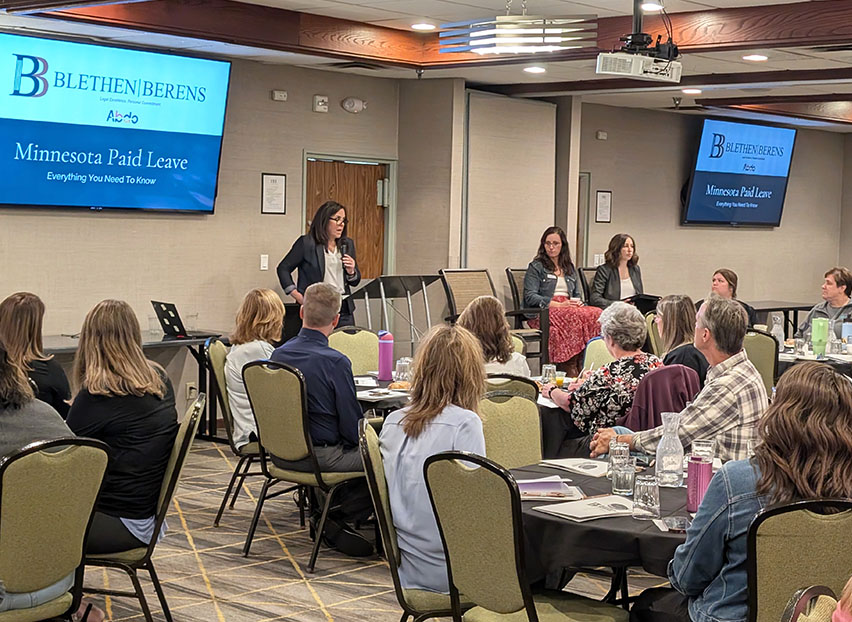Business owners digest paid leave info

ABOVE: A crowd of business owners, HR professionals and payroll workers listen to Blethen and Berens Attorney Julia Ketcham Corbett, at podium, as ABDO HR and Payroll Advisor Leah Davis, left, and fellow Attorney Jacqueline Tousley-Adelman listen before giving their own information.
FAIRMONT – With attorneys and a payroll advisor on hand, dozens of Fairmont business owners and payroll professionals learned about the new Minnesota Paid Leave program at a seminar on Wednesday.
The law provides paid leave benefits to employees effective January 1, 2026. It is funded by premiums, half of which is paid out by employers and half by employees.
Two types of paid leave are available. For a serious medical condition that lasts more than seven days and is certified by a health care provider or other professional, employees can claim paid medical leave for up to 12 weeks.
For family leave including the employee bonding with their baby within the first year after it is born, caring for a family member with a serious medical condition, being needed due to a family member being on or leaving for active armed forces duty and safety reasons such as domestic abuse, sexual assault, or being stalked, employees can claim family leave up to 12 weeks.
“If they qualify for both family and medical leave in the same benefit year, the employee can take up to 20 weeks combined of the two,” Blethen and Berens Attorney Jacqueline Tousley-Adelman said.
Most businesses are required to pay into the program.
Independent contractors, self-employed people and Tribal Nations can opt-in but are not required to. Federal government employees, exempt seasonal employees and railroad employees are the only three types that cannot get Paid Leave.
Tousley-Adelman said those who don’t have to pay into unemployment are not necessarily exempt from the Paid Leave program.
“Religious organizations, nonprofits, agriculture employers and businesses with employed family members all must participate in Minnesota paid leave,” she said.
For business with less than 30 individuals hired in the annual look-back period and an average annual wage of less than $110,000, there are two breaks given to small businesses.
One is a $3,000 grant opportunity for businesses that can prove they had to hire a temp worker or give several hours of overtime to cover the employee on paid leave. The other is they can, instead of covering their full half, only pay 25 percent of the premium into the program. Workers would still have to pay their half.
Only Minnesota employees are eligible for the program. There are two separate definitions of this, of which an employee must match one.
“A Minnesota employee is defined as an employee who works 50 percent or more of the prior year within the physical boundary of Minnesota,” Tousley-Adelman said. “If the employee doesn’t work 50 percent or more in any one state, the employee must live in Minnesota.”
For employers who have remote workers and those who have workers who work in multiple states with paid leave programs, Blethen and Berens Attorney Julia Ketcham Corbett said information will need to be gathered to determine if the employee qualifies for paid leave in Minnesota or not.
The deadline for businesses to notify employees, via a conspicuous workplace poster and by notifying employees directly, must be done by December 1.
For businesses where payroll and HR are separate departments, ABDO HR and Payroll Advisor Leah Davis said both departments would need to spend significant time together on this law change.
“Minnesota paid leave is going to force really close collaboration, or we’re going to get it wrong,” Davis said. “Make sure that everybody along the way from your HR team to the person hitting submit on payroll understands the implications of this. It’s another reason that we need to be collaborating and working together.”
Ketcham Corbett said the law does, unfortunately, have some gray areas. Some businesses may wish to test these areas, but Ketcham said those who do could find themselves subjects of lawsuits where uncertainties are ruled on.
The good news, Ketcham Corbett said, is that she has heard lawmakers on both sides who appear willing to make changes if issues arise from the Paid Leave program.
Other topics covered included whether businesses will allow PTO time to be stacked on top of Paid Leave as an added benefit or not, interactions between Paid Leave and FMLA Parent Leave for larger businesses, and avoiding potential retaliation claims, such as an employer or employee complaining or harassing an employee about their paid leave.
The Paid Leave seminar was held at Best Western in Fairmont and put on by the Fairmont Area Chamber of Commerce, city of Fairmont and Martin County Economic Development Authority. About 130 people were in attendance.
For more information, visit mn.gov/deed/paidleave.

